Completing Divinity: Original Sin this week, I was ratiocinating on what I've come to accept as a preference for games that enable what I'm tentatively dubbing "the reckless adventurer" stratagem - those games that don't scale their encounters to the player's level, but create an open-world where, say, the left path will grind you into paste due to its absurdly high-level encounters with the implication being that you should probably go right instead. While these games are often disheartening due to the frequency of taking the wrong road to Pulverization City (not that there's necessarily a right road to Pulverization City...), some of them offer the opportunity for a particularly stealthy (or fast (or foolhardy)) player to dart into a location where they absolutely should not yet be and possibly get away with a few high-level items at the risk of their own utter annihilation.
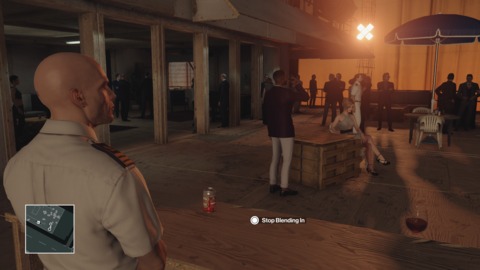
Like practically every video game analogy, at least of those that don't compare a game to a certain Orson Welles movie, Dark Souls and its brethren are some of the more visible examples of this particular world-building methodology in recent years. Right when you touch down at the Firelink Shrine after the extended tutorial dungeon, the first Dark Souls directs you towards two destinations: one above the town and one below. The player will then bash their head against the skeletons on the lower path for a few fatal encounters before opting for the preferential top route into the Undead Burg. Yet, there are regions which are all but marked "bad times ahead" with a bloody signpost that a less risk-averse player might choose to poke their head into for a powerful item, such as the upgrade-enabling embers or a particularly good weapon or armor set. Speedrunners will spend hours figuring out ways to pass through entire high-level areas without incident, ditto for the equally tough boss encounters, but even a novice player knows that while death is inevitable in the Souls series, and with it the loss of any souls they might be carrying, you will always keep any item you manage to find before ol' Grimmy Reapz catches up to you and delivers the foregone conclusion to your audacious daredevil antics.
But this has been a reliable if precarious tactic in many RPGs for years, albeit the few of those that don't have random encounters (because you can't tiptoe around those), crowds of enemies that always know exactly where you are (so Diablo's out), or enemy-scaling (like the Bethesda games). The original Risen had a lot of cases where you could sneak around one-shot murder skeletons for some wonderful loot, which in turn was a hazard-filled holdover from the development team's work on the Gothic series. The Baldur's Gate series let you Bilbo your way past gigantic screen-filling demons and dragons for the treasures they were half-heartedly guarding (Icewind Dale, meanwhile, was too linear to allow for much "sequence breaking" of this type).
Obviously, there's some pushback to games including a possibility like this, to the extent that we get any of the above deterrents or just more observant high-level bad guys who won't be quite so accommodating to a particularly sneaky rogue party member. But then we're talking about a world that threatens to squish neophyte adventurers simply on the basis of a single unfortunate coin-toss in front of a fork in the path. In cases like those, you need every boon and lucky break you can get your hands on, even if it means potentially breaking the game for yourself in the process. It's situations like those, where the odds are against you unless you make your own luck, that endears the RPG experience as a whole to me. How about you all? There's gotta be someone out there who still thinks random encounters and level-scaling is preferable. I promise I won't throw shade.
New Games!
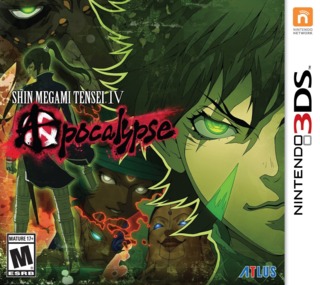
Kind of a quiet seven days, though maybe I'm not looking hard enough. For my MegaTen brothers and sisters, I gotta give Shin Megami Tensei IV: Apocalypse the top spot for what I'm looking forward to most out of this week's releases. While I don't imagine I'll be playing it myself any time soon, I always admire the level of challenge and consideration that goes into each SMT game, and I've heard a lot of promising things about this sequel including its improvements to the story and setting of SMT IV and various other revisions. In my eyes these games are still hardcore Pokémon though, and no amount of rad post-apocalyptic demon wars can sway me. Add a few teenage thieves and a talking cat, though, then maybe we're talking.
In other enhanced anime JRPG remake news, we also have the 150% spookier (not a real statistic) Tokyo Twilight Ghost Hunters: Daybreak Special Gigs coming out for PS3, PS4 and PS Vita, based on last year's middling horror-themed RPG/visual novel Tokyo Twilight Ghost Hunters. This also marks the debut of the series on PS4. Gotta say that this one passed me by, and I very much doubt we'll see anything on it from the crew, but maybe it's no big loss? There are a lot of RPGs out this year, is all I'm saying.

Backing away from spooky animes for a moment, I suppose I'd better acknowledge the first of two big releases this week for the "norms": Forza Horizon 3 for Xbox One. People really seem to take to the Forza Horizon games for finding a happy balance between the rambunctious open-world racing games of a Need for Speed/Burnout bent and Forza's more simulation-heavy car fetish enabling. Me? I've only really enjoyed the games of this type that let me crash into people a lot, which probably says a lot about where my mind is at with regards to our noble, sleek metal couriers. When is the ghost gameplay of Driver: San Francisco making a return?
Talking of big metal things that blow up a lot, we're getting even more Warhammer business this year with Warhammer 40,000: Eternal Crusade. What is becoming a recurring worrisome element to these rundowns is another acknowledgement that I don't have a whole lot of familiarity with this universe - my WH40k knowhow begins and ends with Space Crusade for the Atari ST - but I know Vinny digs anything coming from the God Emperor and his metal boys. Then again, we're talking about a massively multiplayer shooter, so maybe it won't be in Vinny's dreadnought wheelhouse after all.
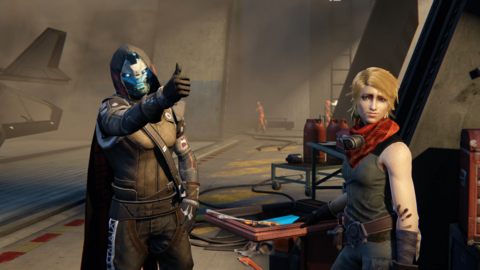
And then there's that other big release I can't exactly avoid: Destiny: Rise of Iron, the newest expansion to Destiny. As in, that one game that apparently won't be getting a sequel anytime soon because they keep putting out content boosts for it instead. I'm sure those it has ensnared in its loot grind cycle will be ecstatic for the few extra light levels it provides, or whatever elite-tier reward system that game doles out now. More likely, they're presently busy trying to convince their old crew, who have all moved onto better games, to come back for a brand new ten-hour long raid dungeon. Excelsior, I say unto them.
Rounding out the rest of the week's releases, we have the last stop for Drinkbox's Severed as it makes its way to the Wii U this week; TheChineseRoom's Scottish tourism simulator Dear Esther from heads to the new consoles for some high definition Hebridean fun walking; and Firewatch makes a belated debut for the Xbox One after its launch at the start of this year, allowing Xbox One owners to finally answer one of humanity's greatest questions for themselves: "Why did I buy this console?" "What is Firewatch?". And, yeah, the second episode of that Batman series from Telltale is out this week too. I said on the last Sunday Summaries that I'd probably mention it again but have nothing else to say, and here I am fulfilling that promise. I am, if nothing else, a man of my word.
Wiki!
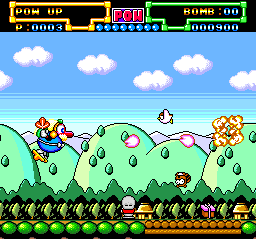
Well, then, let's talk about the PC Engine some more. I've been hammering away at the remaining HuCard games - those are the TurboGrafx-16 games that were released on little SD card things, rather than CDs - and have made a little more progress with 1991's output. To put it in more accurate terms, I processed another ten pages this week. Might as well go through them all quickly, as there's nothing too substantial here:
- Racing Damashii, or Racing Spirits, is a motorcycle racing game that borrows Hang-On's behind-the-biker perspective. It's one of those games that is configured for a two-player view whether there's a second player or not, so often the bottom screen just shows you how your CPU opponent is doing. This is actually an Irem game, and so it's a little out of the ordinary for the company that was mostly focusing on Arcade shoot 'em ups at this time.
- Every week where I'm working on some Japan-exclusive smattering of Super Famicom or PC Engine games I run into a case like Skweek. Despite this being a Japan-exclusive port, Skweek is actually a European game - from French studio Loriciel who you might know for... well, not a whole lot besides maybe Best of the Best: Championship Karate or Jim Power - and it plays like Q*Bert but without all the hopping. The goal is to run over every tile in each stage, coloring them all pink in the process. The game never seems to stop throwing new enemies and obstacles at you either, including arrows that force you to move one direction and teleporters and many more besides. Oddly enough, the game only saw one release in North America, and it was for the Game Gear of all systems. If you had a Game Gear or followed that scene back in the day, you might know it better as Slider. That particular port was put out by the same Japanese company that worked on this PC Engine version, and you could reasonably infer that the two are identical but for some necessary resolution squeezing.
- It took some searching to figure out which is the correct way to write the title of this next game, Hanata-Kadaka!?, but I think I got it right based on the punctuation used in the box art. This is one of those cartoony shoot 'em ups that actually resembles Kiki Kaikai (a.k.a. Pocky & Rocky) as if it was instead more of a traditional horizontal shoot 'em up than the dual-joystick sort of affair it actually is. The player, as a helpful long-nosed tengu (of the sort that shows up as the final boss in Dead or Alive 2), is helping a kitsune rescue his girlfriend from an evil tanuki. I'm not sure if it necessarily fits that the tengu is a good guy and the tanuki a villain, but it doesn't strike me as a particularly serious game. It's tough though, in part because one of the major power-ups also increases the size of your hitbox, and it has a few of those Gradius stages where you have to carve a path through some destructible environments or get crushed.
- Power League 4 is some regular-ass Japanese baseball, and Hudson presumably felt it was prudent that the PC Engine had its own version of an annual baseball series to rival the Famicom's. It doesn't really add a whole lot to the previous game's formula though, and I'm not sure it even has real team and player names to update for a new season of professional baseball to use as an excuse, so I kind of wonder what the point is. It does have nighttime versions of all its stadiums now, at least, including for whatever reason the one with the dome roof.
- We saw 1943 Kai last week, and this week sees another Capcom Arcade WW2 shoot 'em up conversion with 1941 Counter Attack. Considered one of the better games in that series, 1941 also has the special distinction of being the fifth and final game developed for the enhanced SuperGrafx system. It's as close to Arcade perfect as PC Engine games would get in a while.
- Power Gate, meanwhile, represents the other side of the PC Engine shoot 'em up spectrum: one that was developed for the PC Engine exclusively, and is kind of terrible. It's an indication that people were flocking to the PC Engine for its many shoot 'em ups, and that desperate lesser developers were throwing together whatever they could make to get a piece of that action.
- For such a wrestling-friendly site, it's weird that I have to keep adding Fire Pro Wrestling games to the database. Surely someone right at the inception of the Giant Bomb wiki would've created all those pages, if not filled them in with all the in-depth puroresu techniques and references that the series is known for. Fire Pro Wrestling 2nd Bout makes some small progress following FPW: Combination Tag, adding a few more match types and fictional (but you know who they are) wrestlers to the mix. It'll take a while longer before it becomes the powerhouse of the 16-bit era that its fanbase knows it as.
- World Jockey is Namco's take on the horseracing genre that would become inexplicably popular on Nintendo systems, but makes a slight detour by focusing on the racing itself rather than the simulation elements going on around it. Except for a mode where players bet on automated races, you're racing those horses directly in most cases, balancing speed with stamina to ensure you end the race as the winner.
- It was nice to see Dragon Egg again. I looked at this game a while back as part of Octurbo, and it is the last of the HuCard games I covered in that series to show up in these TurboGrafx/PC Engine wiki projects. It's a fairly standard platformer of the Wonder Boy model - that is, you earn money from killing enemies that you can then spend at stores for power-ups, but that's as "RPG" as it ever gets - but you also have something of a shoot 'em up system of incrementally stronger power-ups that last until you lose a life. The power-ups are for the titular ovum you're carrying around: initially, all you can do is bonk enemies with the egg itself, but then it becomes a baby dragon able to breathe fire before eventually becoming a winged dragon mount that makes the platforming substantially easier. As long as you don't die, the game's a breeze. Sorta like life?
- I'll sign off with Morita Shogi PC, a shogi game that - like anything attached to the Morita name - was developed by a small shogi development company called Random House, not to be confused with the book publisher. This game's one big distinction is a graphical setting that turns the shogi board into Battle Chess, except instead of animated knights and bishops it's all JRPG monsters like rock golems and slimes. It's weird that the Dragon Quest people never reached out for a version of this game with their own monster designs - a lot of them are faintly familiar.
Divinity: Original Sin!
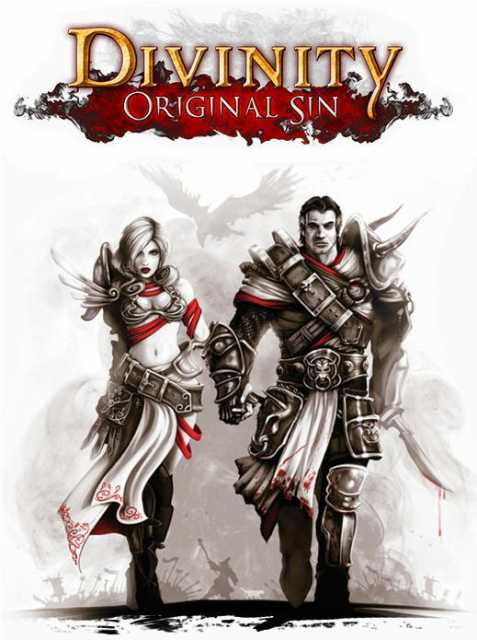
While I am glad that my impulsive drive to start yet another giant game so soon after the last one (or two, or three) didn't lead to yet another whole month dedicated to a single game, I was sad to see Divinity: Original Sin eventually end. I think it's one of my favorite RPGs in a long time because of how complex it was willing to get with its strategic combat. Now, while I'm someone who will regularly tout story and characters as a significant component to an RPG's overall quality, I will always, always point to a well-considered and well-realized combat engine and a smattering of player-convenience features as the most important qualities of a game from this genre. The sole exception being, so far, Planescape: Torment, which almost deliberately shied away from giving players anything resembling a traditional difficulty curve or a conventional set of character progression mechanics - both of which better served the game's oblique and wonderful story and setting than something more traditional would have done.
Divinity's story, meanwhile, does some fun stuff with the nature of its world and specifically how it formed in the first place and how it threatens to come undone before its due time. This sort of meta-narrative has been done plenty of times before, as is often the case for games where the stakes apparently need to be raised from "save the world" to "save all of existence" (consider the ridiculous final act of Final Fantasy IX, as another example), but at the same time I appreciated how weird the game was willing to get with its hub world hovering at the end of time. Again, I can think of at least two RPGs that offered a very similar hub environment with which to rest and recuperate - Chrono Trigger and Baldur's Gate 2: Throne of Bhaal, in case you were thinking of calling my bluff - but it served to introduce a deeper mystery behind the game's events occurring concurrently with what was happening on the surface. Needless to say, I won't get into any more details on it here for the sake of spoilers, but it's always brave when a developer takes the time to create a whole fantasy world and then lifts the veil to see its inner-workings. Or maybe it's getting trite. I guess that's all in the eye of the beholder and how tired folk are getting of RPGs getting all metaphysical on you. All it needed was to peel back the onion one more layer and we'd see a giant Dungeon Master's screen surrounding all of creation.
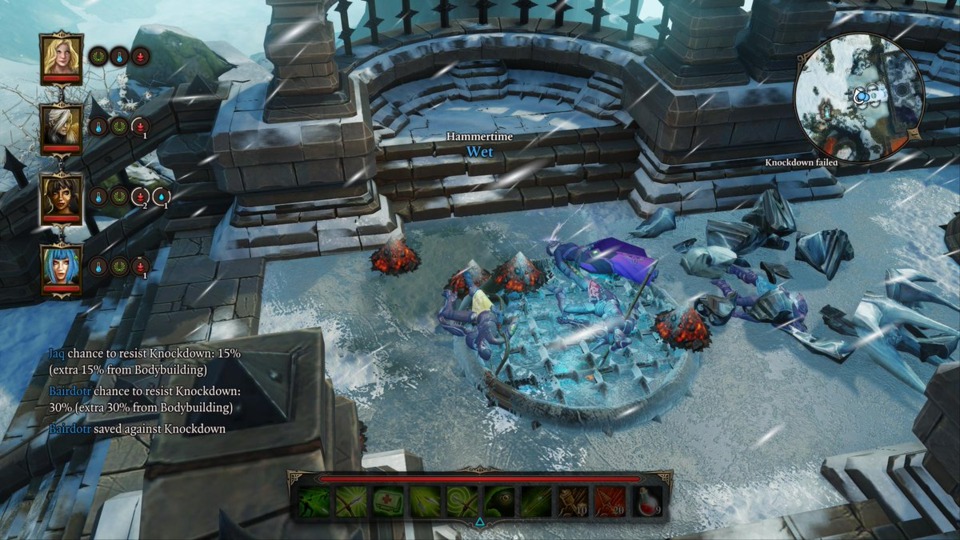
The combat, then. I spoke at length last week about the game's use of elemental and environmental hazards, putting more emphasis on using the battlefield to the player's advantage beyond the usual RPG tricks of creating bottlenecks and the like. What impressed me to an equal extent was how the game managed a level of complexity while simultaneously streamlining what would normally be a dizzying amount of options available. Consider many RPGs of the D&D mold, where mages have a thousand spells to call upon for the sake of mirroring the table-top's equivalent degree of versatility. In Divinity's more considered mage library, it's all killer no filler - every spell, even the basic tier ones, retain their usefulness long into the game. Maybe that speaks to how ineffective I am as a mage in more overtly D&D-inspired games, but having about ten to twenty spells with various distinct applications was just enough to wrap my head around. I didn't need to stumble over finding the absolute perfect spell for any given situation - since there were fewer to keep track of, I'd always remember which one would work best in the moment. Rather than worrying about mana or spell charges, the game does the MMO thing of putting every spell on a cooldown - the most powerful of which opting instead for a "one and done" deal for any given combat encounter - that not only didn't freeze you out of using the same spell type based on an arbitrary limitation (though I guess the cooldown is also that) but motivated you to try out the spells you used less often while the mainstays were on timers, which in turn helped you discover how useful some of those "forgettable" spells could be. The spells that do no damage but caused status effects with higher probability turned out to be incredibly useful for some battles - the low-cost "Bitter Cold" spell in particular, which could freeze enemies and take them out of the battle for two turns, was frequently a godsend against opponents who seemed to summon half a menagerie every turn. Hell, I think this was one of the first games that helped impress upon me just how vital mages could be as their repertoires filled up. I guess after twenty-five years of playing games like this, it had to happen eventually.
All the same, it was my tank and my archer that ended up being the most damaging. The game pulls a reverse balance of RPG hero power here, making the elemental mages less powerful than the physical classes as the game heads towards its conclusion, in part due to the heavy presence of undead enemies at the beginning of the game. These undead were resistant to slashing and piercing weapons - swords were a bad choice - but really didn't like fire a whole lot, but towards the end of the game more and more of the enemies were demons resistant to practically every element, and far more susceptible to getting wanged on the head with something sharp. My archer picked up an ability called "rain of arrows" which did absolutely broken damage, to the extent that I wonder if the designers or myself did something wrong somewhere. As someone who usually relies on the burlier classes when playing the table-top game (or RPGs with single characters), I appreciate that the game gives them their due rather than letting them be glorified meatshields for the bookish nuke-hurlers in the party.
To finish, I just want to give a shout out to one of the game's unspoken heroes: its vibrant presentation. The game looks great in general, though it's happy to take a certain last-gen model of a distant, top-down Diablo/Neverwinter Nights-style perspective which complements its tactical combat but does considerably less for its character models. Additionally, however, the game is colorful and bright and its characters distinct to an almost cartoonish extent. The game has plenty of humor, for better or worse, and while it delves into some pretty dark material with regards to human sacrifice, torture, gleeful nihilism, gross poison-spewing undead creatures, at least one implication of incest, and a lot of moral relativism with its personality-based "trait" system that lets role-playing gamers justify a lot of really iffy decisions, it is in general a lighthearted game and a tonic to the more serious and dramatically wrought Dragon Age: Inquisition, which I feel was its biggest competition in the year of its release.
At any rate, I think I'm ready to play its sequel whenever it comes out in the next few yea... wait, it's out in December? And the Early Access beta went live a few days ago? Good lord, this RPG backlog never ends...
Gravity Rush: Remastered
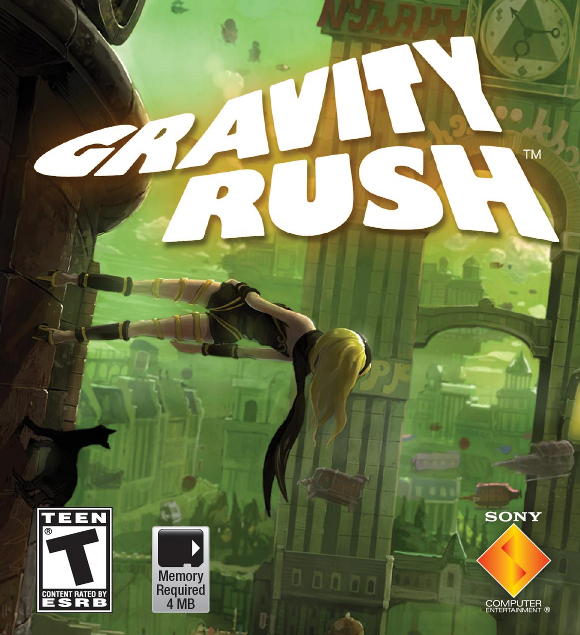
You might be wondering if the decision to play the two games I'm discussing this week was in any way motivated by their imminent upcoming 2016 sequels, and to that I say "not really, but maybe subconsciously?". Gravity Rush is best known as one of the earliest Vita games to grab attention as being its own, uniquely Vita thing. Naturally, that meant that it was due for an improved console port eventually, and that's what Gravity Rush: Remastered is.
Gravity Rush is an open-world game with distinctive traversal mechanics that also factor into its combat, similar to, say, InFamous or Crackdown. It's a bit more compact than most games of its type, however, presumably due to it starting life as a portable game. The traversal mechanic in question is gravity manipulation, as you could probably surmise from the title, allowing the player to release themselves from gravity's clutches and float through the air. The player can hover around, but to get anywhere they merely have to look in a direction and hit the trigger button to whoosh away in that direction. Hitting the side or ceiling of a structure allows you to walk along it as if it was the ground, which is a little vertiginous at first but quickly becomes second nature. A lot of the time you'll be using this gravity manipulation as a form of flight, moving through the air quickly rather than sprinting across the side of a building. It seems about as fast at least, and not nearly as bewildering. Combat's been fairly basic so far too, but then I think the game is treating me with kid gloves for these early parts - it does take some time getting to grips with all the floating. Beyond that, it has a level progression system tied to purple gemstones that allows you to increase the power of your attacks, your health and how long you can stay in the air, but presently the emphasis seems to be on the story and gameplay rather than tossing too many collectibles on a map for you to find. Not that I really believe there's such a thing as too many collectibles, but we all know I'm weird about that stuff.

The game's aesthetic is all over the place, though not necessarily in a pejorative sense. The game's initial setting of Auldnoir is very definitely of French origin, with characters speaking in a language at least adjacent to French and the gentle melodic background music also reminiscent of that big ol' hexagon of a country. Now, even with my intrinsic enmity of the French as a citizen of the United Kingdom, there's a lot of games I love - especially Japanese ones - that have a French affectation; Dark Cloud 2 being on the top of that list (where, indeed, it belongs on most any list). The game has a gentle carefree nature to it with this influence, as you gracefully - or not so gracefully, depending on how well I'm wrestling with the controls - float around looking for gems or "nevi" creatures to divekick. There's two other major visual influences competing with that one, however; the game's distinct washed out cel-shaded characters, possibly to make a statement about the city's present lack of vitality (pun intended?) with the issues it's facing from troubles both foreign and domestic, and the unusual decision to use a type of font - and a cutscene presentation style - reminiscent of comic books. The font in particular is very familiar to me, though I couldn't name the specific typeface: it's one often used by Marvel, and frequently appears in stylish comic book games like various recent Spider-Mans, or XIII from a few generations ago, which elect to generate big onomatopoeic speech bubbles whenever you hit something. Yet, this style of action comic isn't what I associate with France or francophonic countries at all, with the single exception of the aforementioned XIII - I always picture them more in the style of Asterix or Tintin (which is Belgian, admittedly, but as we say on the continent "that's close enough to French to not matter". See also: Luxembourg, Switzerland). Kind of jarring, but the game makes it work.
I'll be continuing this game in the week to come, and I hope it continues to be a breath of fresh air from the huge, engrossing games that I've been burying myself in of late. At the very least its gravity-switching isn't making me want to throw up after a few hours, so that's a good omen.
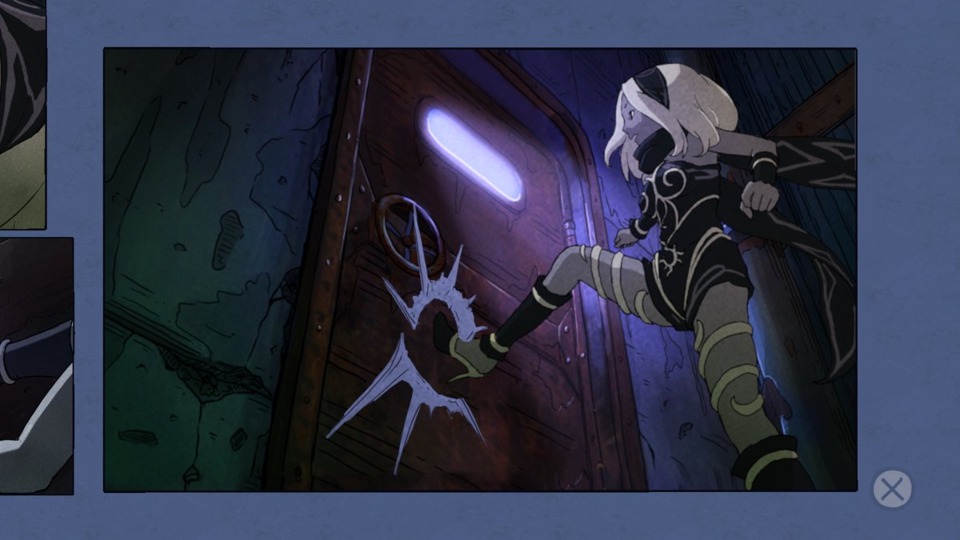
Log in to comment